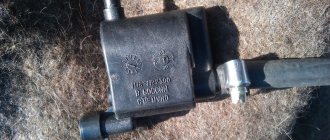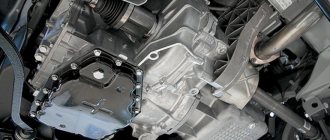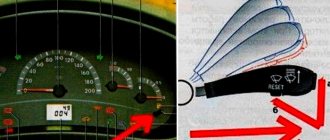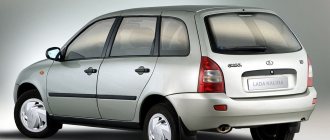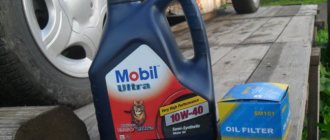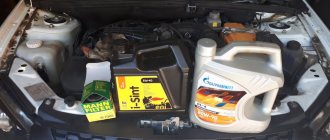The gas tank of any car always contains vapors formed due to a decrease in atmospheric pressure or heating of the fuel. In order to prevent the leakage of fuel vapors into the vehicle, a special gasoline vapor recovery system (VPSU) is installed. Thanks to it, the vapors retained by the adsorber (essentially activated carbon) enter the intake manifold and burn in the engine cylinders. To regulate the amount of gasoline vapor coming from the adsorber to the manifold, a special solenoid valve is used.
Why do you need a gasoline vapor recovery system?
Injection vehicles (including Kalina), whose environmental class belongs to Euro-3, must be equipped with an EPS. This prevents fuel vapors from entering the atmosphere, polluting it. In addition, the system guarantees more stable operation of the power plant and saves gasoline. How to check the adsorber valve included in the SUBS and how it functions will be discussed further.
Additional features
How to replace a marker lamp on a viburnum
Of course, initially, created to create environmentally friendly engine operation, the Lada Granta adsorber, the price of which is insignificant, was underestimated. Manufacturers tried with all sorts of tricks to circumvent this newfangled trend, but the law obliged all car manufacturers who did not comply with this innovation to pay heavy fines.
Although AvtoVAZ has never been known for its large exports, it was forced to take measures to install an adsorber, since it has a small, but still a sales market. Today, the adsorber is installed on the Lada Granta without fail, since world research has revealed the following capabilities of this component:
— reduction in gasoline consumption
A similar result is achieved because the adsorber valve allows gases to be driven back into the gas tank, from where they enter the engine, which, when warm, is capable of processing them. If this device is missing, or the canister valve itself does not work, Granta loses fuel, which significantly increases consumption.
— normalization of the exhaust system
Thanks to filtration, the likelihood of premature wear of the system and its components disappears.
Principle of operation
The adsorber itself allows fuel vapors to accumulate in a special place - the separator. As a result, gasoline turns into condensate and goes back to the tank. Vapors that have not undergone treatment go through double valves of the system, one of which prevents fuel from spilling out during an emergency (for example, a coup), and the second “is engaged” in regulating the pressure in the tank. The adsorber purge valve is located under the hood, and the adsorber itself is located on the tank. The control unit ensures the normal operation of the entire system: it ventilates and removes condensation.
Replacing the adsorber on VAZ 2104, VAZ 2105, VAZ 2107
Welcome! Adsorber - someone removes it immediately after buying a car, and someone leaves it and drives until it becomes unusable, and after it arrives, they either throw it away and buy a new one, or they throw it away and continue to drive without it, turning it off in the same way at the same time, through the diagnostic connector there is an error that will then constantly light up on the dashboard (check engine) after you remove the adsorber and thereby turn off the purge valve that relates to it and do some other little things related to the hose that goes from the separator to the adsorber and with a hose that comes from the valve itself.
Design and operation of the adsorber purge valve
The KPA is an electromagnetic locking device that operates from the vehicle’s on-board network. The valve consists of:
- plastic case;
- valve with spring;
- windings;
- metal core;
- connector
When the vehicle's engine is turned off, no voltage is supplied to the valve and it remains in the closed position. That is, on the motor side, the system that captures vapors is blocked. At the same time, the adsorber begins to “collect” vapors. When the power unit starts, voltage is applied to the valve, causing it to open and fuel vapors to enter the intake manifold. As soon as the ignition is turned off, the control unit is de-energized and the pipeline is closed: no vapors enter the receiver.
Cars of a high price category have a more complex evaporation system. Such machines have special sensors that can “calculate” the amount of air and vapor as a percentage. This allows you to more accurately control the supply of gasoline to the injector.
Description of design
Engine power system diagram
: 1 - separator; 2 - filling pipe; 3 — hose for supplying fuel vapor from the tank to the separator; 4 — pipe for removing fuel vapors from the separator to the adsorber; 5 — ventilation tube; 6 — ventilation tube hose; 7 — filling pipe hose; 8 — fuel tank; 9 - tee; 10 - adsorber; 11 — fuel supply tube to the fuel rail; 12 — tube for supplying fuel vapor to the solenoid valve for purge the adsorber; 13 — solenoid valve for purge of the adsorber; 14 — fuel rail with injectors; 15 — throttle assembly; 16 — fuel supply hose to the tee; 17 — fuel filter; 18 — fuel supply hose to the fuel filter; 19 - fuel module.
Fuel is supplied from a tank installed under the bottom in the rear seat area. The fuel tank consists of two stamped steel parts welded together. The filling pipe is connected to the tank with a gas-resistant rubber hose. A ventilation tube is welded into the upper part of the filling pipe, connected to the tank with a plastic hose. The ventilation tube is used to remove air displaced from the tank when it is filled with fuel. The fuel tank ventilation inlet and outlet valves are built into the filler plug.
Fuel module The fuel module, including the fuel pump, fuel pressure regulator and fuel level sensor, is installed in the fuel tank. For rough fuel cleaning, there is a strainer at the module inlet.
Fuel level indicator sensor The fuel level indicator sensor controls the operation of the dial gauge and signaling device located in the instrument cluster.
Fuel pump Fuel pump - electric, submersible, rotary. The fuel pump is turned on by a command from the electronic control unit (controller) when the ignition is turned on, through a relay. The pump creates a pressure in the system that exceeds the operating pressure in the fuel rail
Fuel filter From the pump, fuel is supplied under pressure to the fuel filter. The fine fuel filter is non-separable, with a paper filter element. The filter is mounted on the fuel tank bracket, on the right. There is an arrow on the filter housing that must coincide with the direction of fuel movement.
Fuel pressure regulator with o-rings After the filter, a tee is built into the fuel delivery line, through which fuel is supplied to the fuel rail and the fuel pressure regulator located in the fuel module. The fuel pressure regulator is a valve that opens when the fuel pressure in the line exceeds, releasing part of the fuel into the tank. The pressure regulator is non-separable and must be replaced if it fails.
Fuel rail The fuel pressure in the fuel rail with the ignition on and the engine not running should be between 3.6 and 4.0 bar. The fuel rail is a tube with injectors installed on it. The ramp is attached to the inlet pipe with two screws. Fuel under pressure is supplied to the internal cavity of the ramp, and from there through nozzles into the intake pipe.
Injector with O-rings The injector is an electromagnetic valve that allows fuel to pass through when voltage is applied to it and is closed by the action of a return spring when there is no power. At the injector outlet there is a sprayer through which fuel is injected into the intake tract. The controller controls the operation of the injectors. The injectors are sealed in the ramp and inlet pipe with rubber rings and fixed to the ramp with metal clips. If the winding is broken or shorted, the injector should be replaced. If the injectors are clogged, they can be washed without dismantling at a special service station.
Air supply elements to the throttle assembly
: 1 — air intake; 2 — air filter; 3 — mass air flow sensor housing; 4 — air supply hose to the throttle assembly; 5 - hose of the main crankcase ventilation circuit. Air is supplied to the engine throttle assembly through the air intake, air filter and corrugated rubber hose. The air filter is installed in the front left part of the engine compartment on three rubber holders (supports). The filter element is paper. After the filter, the air passes through the mass air flow sensor.
Throttle assembly The throttle assembly is a throttle body (with channels made in it), on which the idle speed regulator and throttle position sensor are installed. The throttle assembly is mounted on the intake pipe. To avoid freezing of the throttle assembly at low temperatures and high ambient humidity, a heating unit is built into the assembly, through which the cooling system fluid circulates. When you press the gas pedal, the throttle valve opens, changing the amount of air entering the engine (the fuel supply is calculated by the controller depending on the air flow).
Idle air control (IAC). When the engine is idling (throttle valve closed), the controller controls the air supply using the idle air control (IAC). The idle air control is a stepper motor that moves the valve. The valve shut-off element (needle) changes the flow area of the channel and provides regulation of air flow bypassing the throttle valve. To increase the crankshaft rotation speed at idle, the controller sends a control signal to open the valve, increasing the air supply bypassing the throttle valve, and, conversely, to reduce the rotation speed, a command is sent to close the valve. In addition to controlling the crankshaft rotation speed at idle, the controller controls the IAC, reducing the toxicity of exhaust gases: when braking the engine, the throttle valve closes sharply. In this case, the IAC increases the air supply bypassing the throttle valve, resulting in a leaner fuel mixture. This helps reduce hydrocarbon and carbon monoxide emissions. The idle air control is non-separable and must be replaced if it fails.
Signs of a malfunction of the control unit
First, start the engine: at idle or in cold weather, you will hear a characteristic, barely audible chirping sound. It indicates that the valve is working properly. In order not to confuse this sound with the noise from a working timing belt, sharply press the gas. The character of the chatter should not change. The following signs indicate a malfunction of the control unit:
- lighting of the CHECK signal on the instrument panel;
- determination of error PO441 during testing;
- increased gasoline consumption;
- unstable operation of the power unit when driving;
- unstable idle;
- increase in CO2 content;
- a hissing sound when unscrewing the tank lid (a vacuum has appeared);
- the appearance of a fuel smell in the cabin.
Error P0441
Owners of Lada Kalina often note that during the operation of the car, error P0441 appears, indicating that the gasoline vapor purge system is not operating correctly (the air flow differs from the norm). The cause of this malfunction may be:
- inoperative adsorber valve;
- clogging of the air line from the control unit to the air filter;
- air leakage through connecting pipes.
What should not be immediately considered is the line from the gas tank to the adsorber; here, a breakdown does not in any way affect the readings of the computer or diagnostic scanner. Still, most often Evap-Solenoid fails; this is a characteristic “disease” on Kalina.
If the EVAP valve stops functioning normally, it is not at all necessary that the engine will lose power, the fuel pump will fail, and so on. Mainly due to problems with the control gear, exhaust toxicity increases, and the Check Engine on the dashboard periodically lights up. There are car owners who do not pay attention to the diagnostic warning light, continuing to operate the car, but do not experience any great inconvenience. And most often in such a case, gasoline consumption does not exceed the norm, the engine starts normally, and no serious problems occur in the fuel system.
Related articles:
- User reviews of popular car navigators of 2018 In this article we will look at what are the best car navigators, reviews 2021, what to pay attention to when choosing a navigation device. A car navigator allows [...]
- Electrical equipment of cars Electricity is used to start the engine; electricity powers lighting devices, wiper motors and heaters, and the ignition system of the internal combustion engine. Electricity also […]
- Flushing the cooling system from emulsion and dirt, industrial and folk remedies A new car practically does not cause any trouble to the owner, you just need to carry out maintenance and change the engine oil in the engine on time. But over time, all the knots and [...]
Valve check on site
You will need a tester (voltmeter, multimeter) and a screwdriver. The KPA itself is installed on the radiator frame. The device can be recognized by seeing two tubes approaching it, through which the evaporation moves. Further:
- disconnect the electrical connector from the control unit by releasing the block lock;
- using a multimeter, check for the presence of voltage by touching the negative (black) probe of the device to ground, and the red probe to “A” (the letter on the block connector);
- turn on the ignition: the multimeter should show the vehicle's on-board voltage. If not, check the wiring.
The canister valve is knocking, clicking or clicking
We make sure that the noise comes specifically from the adsorber valve, and not from the timing belt, rollers and other elements. To do this, simply press the gas pedal sharply. If the chattering noise does not change, then the source of the noise is the adsorber valve. It is not uncommon for the clatter of the adsorber valve to appear only in cold weather at sub-zero temperatures.
1. Contact an authorized dealer with the problem. If the adsorber valve is truly faulty, it will be replaced under warranty. If they consider that such valve operation is the norm, then there is no point in writing in support of AvtoVAZ.
2. Advice from car enthusiasts (you lose your warranty!). There is an adjusting screw on the side of the valve, which is filled with glue. Remove the glue and turn the screw clockwise 90 degrees. After this, the adsorber valve no longer clicks in the cold.
Have you encountered problems with the adsorber valve?
Keywords: sound insulation lada xray | sound insulation of Lada Vesta | sound insulation of Lada Largus | soundproofing of Lada Granta | sound insulation of Lada Kalina | sound insulation of Lada Priora | soundproofing 4x4 | lada xray sensors | Lada Vesta sensors | Lada Largus sensors | Lada Granta sensors | Lada Kalina sensors | Lada Priora sensors | 4x4 sensors | ECM Lada Vesta | ECM Lada XRAY | ECM Lada Largus | ECM Lada Granta | ECM Lada Kalina | ECM Lada Priora | ECM 4x4 | universal article
Found an error? Select it and press Ctrl Enter..
- New option Lada Vesta Luxe: leather and Alcantara seats
- Why the Lada Granta does not start, causes of malfunctions
- Comparison of the cost of servicing VAZ and Renault-Nissan engines on LADA
- Installing a protective mesh on the radiator grill of Lada Largus
How to remove the purge valve
Remove the negative terminal from the battery. If the mass air flow sensor (mass air flow sensor) interferes, remove the inlet pipe from it. Then bend the valve mount and pull it up. Now you need to disconnect a couple of fittings. The first one can be removed freely; to pull out the second one, press the latch and pry up the antennae, for example, with a thin screwdriver.
Purpose
This spare part was not always part of the car. We owe its appearance to modern requirements for the environmental performance of cars, and to be more precise, the Lada Granta acquired an adsorber thanks to Euro-3.
(Euro-3 is an environmental standard that was introduced in 1999, but Russian manufacturers were able to meet its requirements only in 2008.)
The adsorber, for which Granta became one of the first “shelters” in the domestic automotive market, is a spare part directly connected to the catalyst. It allows you to accumulate gasoline vapors to prevent them from entering the exhaust manifold.
Such actions allow you to preserve the catalyst and prevent its premature wear, since the combination of a cold catalyst with gasoline vapor is unacceptable. As soon as the engine warms up to the required temperature, the adsorber purge sensor is activated. The adsorber valve drives the vapors back into the gas tank.
Dismantling the adsorber Lada Granta VAZ 2190
- Use a screwdriver to loosen the clamp on the fuel drain hose.
- Remove the hose from the separator fitting.
Remove the hose and unscrew the nuts
- The key is set to “10”, unscrew the three nuts securing the separator body to the car body.
- We remove the gravity valve.
- We remove the separator.
- We install a new separator and assemble the structure in the reverse order.
- We remove the adsorber, remove it from the retainer, replace it with a new one, and assemble the parts in the reverse order.
Removing the adsorber
Let's sum it up
The work of replacing the valve is simple, however, when the owner of a Lada Kalina is not confident in his capabilities or does not show the desire to carry out repair operations in such a high-risk unit as the fuel supply system, we recommend using the services of a specialized workshop.
EGR valve: what is it
The car's EGR Exhaust Gas Recirculation system is a very vague and rather capricious thing, especially with the very low quality of fuel that is found in our area, quite often. The ambiguity of this system lies in the fact that its purpose is purely environmental. waste recycling system
gases or USR, is designed to reduce the amount of nitrogen oxides in the car exhaust. What is the USR, why is it needed and how its malfunctions are expressed, we will talk about all this for now.
Why do they refuse the adsorber?
Despite the advantages of this design solution, and these are: fuel economy, absence of odor in the cabin, reduction of harmful emissions into the atmosphere (although many do not care about this), the adsorber has a number of significant drawbacks, due to which many seek to disable it or completely remove it.
Disadvantages, they are also signs of malfunction:
- Expensiveness of the product (not for all cars). Replace or remove? More often, preference is given to the second option. For example, on an Acura MDX the price of the product varies within 10,000 rubles. For VAZ – from 800 rubles.
- A malfunction of the device leads to interruptions in the operation of the unit: the engine does not pull (poor acceleration of the car, stalls when driving uphill, transporting goods, floating idle speed on a warm engine, if the tank is plastic, then with a clogged adsorber, constantly compressing and unclenching (in the absence of a bypass valve in the lid), it may eventually burst due to the pressure of gasoline vapors; if it is metal, then it will become deformed. One of the characteristic signs of a malfunctioning adsorber is a hissing sound when the fuel tank lid is opened, caused by the movement of air into the tank (not out) and the appearance of the smell of gasoline in the cabin, incorrect fuel level.The appearance of error p0443 (the cause of the error is a clogged or faulty solenoid valve).
Therefore, when a product fails, many people turn it off and remove it, or take a more complicated path - they open the case and replace the old activated carbon with a new one.
EGR system malfunctions
Diagnosing problems with the described system is not as simple a task as it might seem at first glance. The trouble is that there are no pronounced symptoms characteristic of EGR problems. The engine seems to be running rough, it seems to be malfunctioning, but it doesn’t seem to be. And only a professional can suspect the exhaust gas recirculation system of such unstable engine operation. But before that, various sensors, components and systems of the car are checked. Actually, what problems may arise here:
- deposits of soot and other elements on the parts of the EGR valve, leading to it jamming in any position;
- burnout of the EGR valve;
- clogging of the USR line itself;
- violation of electronic control systems for the USR valve;
If a valve or line is simply clogged, cleaning them, in general, is not difficult, although in some cases such cleaning is simply impossible. Well, if the valve burns out, then you will have to change it, and this, as already mentioned, is by no means cheap.
There are virtually no symptoms specific to problems with the EGR valve. This is, for example, unstable engine operation at idle speed, unmotivated dips in power, lack of pronounced acceleration when the throttle valve is fully opened, and other signs of disturbances in engine operation.
One way or another, do not rush to change the EGR valve or turn it off if there is no obvious damage to the valve and its parts. Perhaps the problem here is not entirely in the USR, because this system is closely interconnected with other components and systems for regulating air supply and exhaust gas removal.
Main malfunctions of the adsorber
The adsorber is not “immortal” and can also fail. At the same time, a breakdown can be determined only by a number of indirect signs.
For example, a malfunction of the adsorber may be indicated by excessive pressure in the car tank. It’s easy to explain - the vapors accumulate, but there is simply nowhere for them to go. The malfunction manifests itself with hissing sounds when unscrewing the lid.
The second indicator of a breakdown is the floating speed of the car at idle. This phenomenon happens less frequently and there are many more reasons than just a malfunction of the adsorber, but you still shouldn’t lose sight of it.
In the cases mentioned above, the best solution is to simply replace the old device and install a new adsorber. Moreover, it will take no more than 10-15 minutes to complete the work.
Many people do not know where the adsorber is located. But here everything is simple. Open the hood and look for a small cylinder-shaped device located in the lower left corner of the engine compartment.
The adsorber is only a seemingly insignificant element of your car. In fact, it performs important functions and can save your personal budget.
Therefore, if there is a malfunction, do not delay replacing the adsorber valve or the device itself. Have a good trip and of course no breakdowns.
It seemed like such an inconspicuous element, which at first glance is not important for the car, but without which it cannot work properly. Dips appear, the engine “troubles” and the gas tank may even collapse! And all this is due to a faulty adsorber valve
Many people don’t know what it is, how it works and MOST IMPORTANTLY what it affects. Today I will try to put everything into simple terms and describe the main symptoms of a malfunction. It will definitely be useful, so read and watch...
It will definitely be useful, so read and watch...
First, let's start with a definition.
Adsorber (from Latin sorbeo - absorb)
- This is a car system that serves to capture gasoline vapors that come out of the tank. When the engine is running, they are sent to the fuel injection system, namely to. When the engine is turned off, some of the vapors are captured by the separator (it directs them back to the tank), and the remaining vapors enter the adsorber, where they are neutralized.
